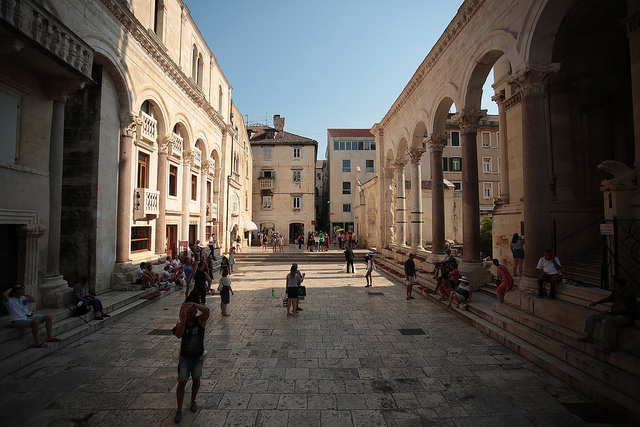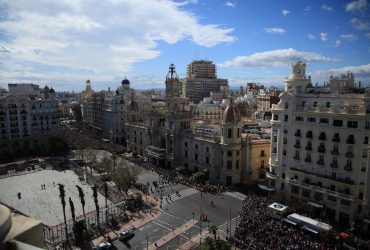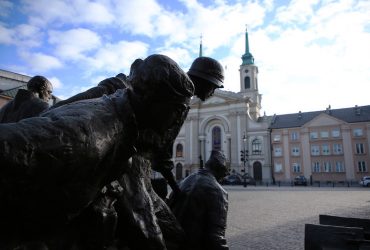When I decided on the itinerary and the places to visit during the trip to Croatia, the city of Split was among the first cities on the list. I knew, thanks to the suggestion of some friends, that Split is a very messy and busy city: that’s why I chose to leave early in the morning and arrive before 10 am (which I strongly recommend to you too), and you can park your car at the parking lot “Vanulično parking Vukovar”
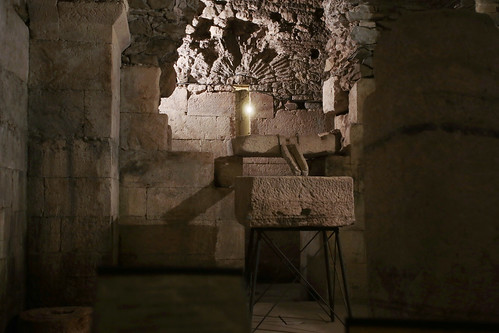 in Ul. Krstulovića dvori. I started visiting the city from the Diocletian’s Palace, for which the town is famous and one of the best-preserved monuments of Roman architecture in the area. If you expect to find a “real palace” with around the town, then immediately abandon this expectation: it is a fortified complex located in the centre of the town, erected by the emperor in the fourth century. Today its remains span a large part of the city centre (around 200 buildings say). It was built between 295 and 304 d.C.
in Ul. Krstulovića dvori. I started visiting the city from the Diocletian’s Palace, for which the town is famous and one of the best-preserved monuments of Roman architecture in the area. If you expect to find a “real palace” with around the town, then immediately abandon this expectation: it is a fortified complex located in the centre of the town, erected by the emperor in the fourth century. Today its remains span a large part of the city centre (around 200 buildings say). It was built between 295 and 304 d.C.
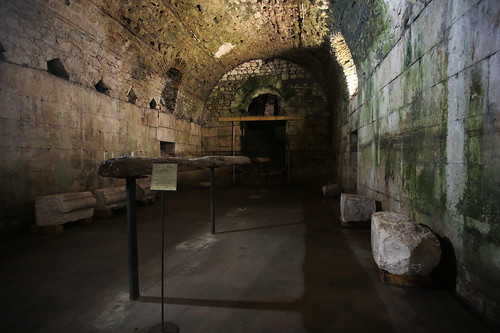 In 650 AD, the inhabitants of Salona (the ancient capital of the Roman province of Dalmatia) took refuge in the palace to escape from the incursions of the Avars (and perhaps even a fire) and according to some the name of the city derived from the Latin Salonae Palatium. Once in here you shouldn’t miss the cells of Diocletian’s palace: they are the strong point of the castle itself and have played a fundamental role in the appointment of the historical core of Split to UNESCO humanity in 1979. The ticket costs 42 kunas per person (about 6 euros), and the ticket office is located, entering from the Porta Aenea, going to the left (second access is from the peristyle). There are numerous explanations, even in Italian, that accurately tell the story of the building and of the city itself. These cells had two main functions: raising the emperor’s apartments and acting as the storehouses of the palace itself. Today they have an even more important: because the rooms that made up these subterranean repeated the layout of the rooms on the upper floor, today they can make us understand and “rebuild” the organisational structure of the building.
In 650 AD, the inhabitants of Salona (the ancient capital of the Roman province of Dalmatia) took refuge in the palace to escape from the incursions of the Avars (and perhaps even a fire) and according to some the name of the city derived from the Latin Salonae Palatium. Once in here you shouldn’t miss the cells of Diocletian’s palace: they are the strong point of the castle itself and have played a fundamental role in the appointment of the historical core of Split to UNESCO humanity in 1979. The ticket costs 42 kunas per person (about 6 euros), and the ticket office is located, entering from the Porta Aenea, going to the left (second access is from the peristyle). There are numerous explanations, even in Italian, that accurately tell the story of the building and of the city itself. These cells had two main functions: raising the emperor’s apartments and acting as the storehouses of the palace itself. Today they have an even more important: because the rooms that made up these subterranean repeated the layout of the rooms on the upper floor, today they can make us understand and “rebuild” the organisational structure of the building.
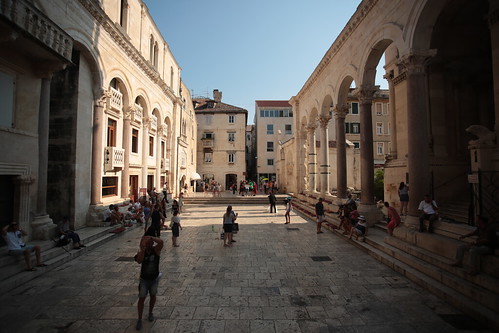 In one of the places were found parts of an oil mill for the production of oil and wine, still exposed today in one room of the palace. In the various rooms, there are also exhibitions and theatrical performances, while the central hall acts as a communication corridor between the Riva and the Peristyle. The Peristyle is, in short, what was once the courtyard of the palace and today is the most photographed square in Split. Around it, in ancient times, there were several temples, and it was dedicated to Emperor Diocletian, to the cult of the living son of Jupiter. The emperor appeared under the arch of the architrave of the central part of
In one of the places were found parts of an oil mill for the production of oil and wine, still exposed today in one room of the palace. In the various rooms, there are also exhibitions and theatrical performances, while the central hall acts as a communication corridor between the Riva and the Peristyle. The Peristyle is, in short, what was once the courtyard of the palace and today is the most photographed square in Split. Around it, in ancient times, there were several temples, and it was dedicated to Emperor Diocletian, to the cult of the living son of Jupiter. The emperor appeared under the arch of the architrave of the central part of
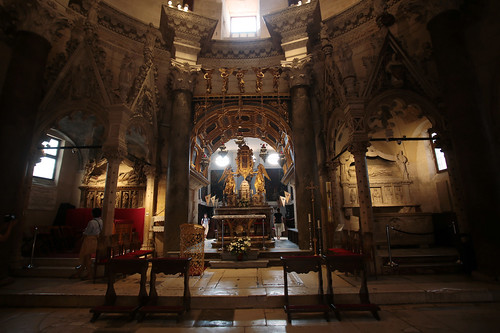 the porch, his subjects approached him and knelt kissed the edges of his purple mantle, or they prostrated themselves before him, remaining with their whole body prostrate on the floor.The clock tower of the Split Basilica stands out on the very high square. The cathedral is smaller than I expected, very “condensed” and certainly noteworthy. To continue the visit, at this point, you can choose between two cumulative tickets:
the porch, his subjects approached him and knelt kissed the edges of his purple mantle, or they prostrated themselves before him, remaining with their whole body prostrate on the floor.The clock tower of the Split Basilica stands out on the very high square. The cathedral is smaller than I expected, very “condensed” and certainly noteworthy. To continue the visit, at this point, you can choose between two cumulative tickets:
1) Basilica, Crypta and Temple of Jupiter at the cost of 25 kunas per person;
2) Basilica, bell tower, Crypta, treasure and Temple of Jupiter for 45 kunas per person;
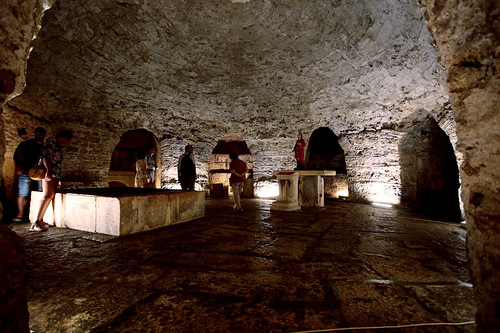 I chose the first ticket because it included the 3 places that most interested me (for the tower of the bell tower, remember that there are steps to do and no lifts). The crypt is not great, and it takes very little for a visit (it is accessed from outside the cathedral itself). The Temple of Jupiter, or the baptistery, is “hidden” between the palaces of the historic centre a 2-minute walk from the cathedral and the peristyle. Do not expect a very large baptistery: the only “room” that makes up the interior is sufficient for the baptismal font, the statue of Jupiter and a handful of visitors at a time (and inside it is also boiling).
I chose the first ticket because it included the 3 places that most interested me (for the tower of the bell tower, remember that there are steps to do and no lifts). The crypt is not great, and it takes very little for a visit (it is accessed from outside the cathedral itself). The Temple of Jupiter, or the baptistery, is “hidden” between the palaces of the historic centre a 2-minute walk from the cathedral and the peristyle. Do not expect a very large baptistery: the only “room” that makes up the interior is sufficient for the baptismal font, the statue of Jupiter and a handful of visitors at a time (and inside it is also boiling).
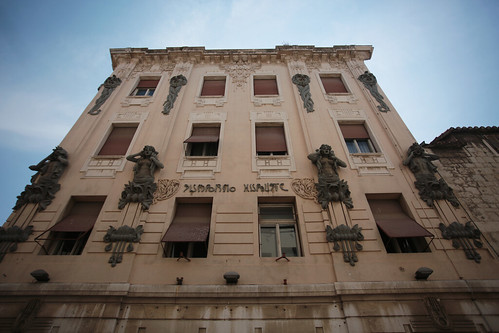 For a coffee break, I chose to stop in Piazza dei Signori (Narodni Trg in Croatian), in the shadow of the old town hall. Not far away is Piazza Della Frutta, whose main attraction is undoubtedly the Venetian tower that rises to the side of the square itself. On the square there are also numerous restaurants, bars and shops: it can, therefore, be an alternative to Piazza dei Signori for a coffee break or lunch. What are the other points of interest in the centre of Split, in addition to its narrow streets that remind the Venetian streets? Its seafront, of course, which runs along the port on one side and the historical part of the city on the other; The ethnographic museum, where essential and representative ethnographic objects of the city’s history are exhibited; the maritime museum, which tells the naval history (military and civil) of Split. Of particular note is the Split Archaeological Museum, the oldest museum in Croatia (it was founded in 1820).
For a coffee break, I chose to stop in Piazza dei Signori (Narodni Trg in Croatian), in the shadow of the old town hall. Not far away is Piazza Della Frutta, whose main attraction is undoubtedly the Venetian tower that rises to the side of the square itself. On the square there are also numerous restaurants, bars and shops: it can, therefore, be an alternative to Piazza dei Signori for a coffee break or lunch. What are the other points of interest in the centre of Split, in addition to its narrow streets that remind the Venetian streets? Its seafront, of course, which runs along the port on one side and the historical part of the city on the other; The ethnographic museum, where essential and representative ethnographic objects of the city’s history are exhibited; the maritime museum, which tells the naval history (military and civil) of Split. Of particular note is the Split Archaeological Museum, the oldest museum in Croatia (it was founded in 1820).
 Personally, I concluded the tour of the city in front of the Porta Aurea, the main monumental gate of the city walls. This gate was the most important to the town, located on the north-south axis and opposite to the sea, and was part of the Diocletian’s palace.
Personally, I concluded the tour of the city in front of the Porta Aurea, the main monumental gate of the city walls. This gate was the most important to the town, located on the north-south axis and opposite to the sea, and was part of the Diocletian’s palace.
In some aspects, like two towers with an octagonal base (now disappeared), the door resembled two other monumental gates (Argentea and Ferrea). This “porta” was distinguished by a more sumptuous decoration, with niches on either side of the passage arch (probably containing in ancient statues) and surmounted by small domes on hanging columns (of which today only the base brackets and capitals remain). From here back to the seafront, where there are many places to stop for a meal or an aperitif, it’s straightforward: the only thing to keep in mind is that they could be very crowded, especially in the hours preceding ferry departures and cruise ships (late afternoon especially)
What to do in Split – Dalmatia
